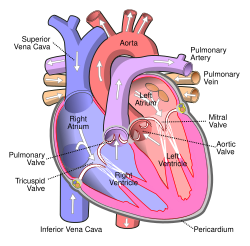Cardiovacular disease in the elderly
With increasing life expectancy, the importance of geriatric medicine is increasing. Even in old age, the most common cause of death is cardiovascular diseases (ischemic heart disease and myocardial infarction). However, in older age groups, there are specific changes in the heart: aortic valve calcification, annular calcification, and senile amyloidosis of the heart.
Aortic valve calcification[edit | edit source]
This is the calcification of a normal tricuspid valve. The etiology of it is not yet known, it is probably due to long-term use of the valve from mechanical stress (blood, pressure, repeated valve flexion), biochemical stress (hypercholesterolemia, hypercalcemia). The process begins at the base of the valve and increases with age. The deposits gradually enlarge, mostly on the aortic valve. The valves then become harder and less mobile. In more severe cases, there is also narrowing of the valve, which results in aortic stenosis.
Annular calcification[edit | edit source]
Calcification is formed at an angle between the mitral valve and the left ventricular wall, i.e. below the site of valve attachment - submitrally. The process begins at the posterior tip as small nodules, then grows to larger nodules to a continuous calcium ring with a diameter of 10 mm. However, the valve itself is normal.
Calcification can also penetrate the left ventricular or septal myocardium. It can even damage the transmission system and cause atrial conduction blockages. This type of calcification is probably formed due to:
- increased left ventricular pressure caused by arterial hypertension, aortic stenosis or hypertrophic cardiomyopathy;
- diabetes mellitus;
- hypercholesterolemia.
All three factors are also at risk for atherosclerosis.
Senile cardiac amyloidosis[edit | edit source]
It is rare in the elderly and middle-aged. However, in old age it is relatively common, specially in people over 75, it occurs in up to 85% of individuals. The precursor for amyloid is ANP - atrial natriuretic peptide. Clinically, senile amyloid manifests as a restrictive cardiomyopathy. Under the microscope, very small deposits of amyloid can be seen subendocardially in both atria, this can only be demonstrated by specific staining dyes(saturna red or congo red).
In 3% of people, amyloid is more massive and also affects the ventricular myocardium (systemic cardiac amyloid) and it can lead to heart failure. In this type, the precursor is prealbumin.
Sources[edit | edit source]
Related links[edit | edit source]
Bibliography[edit | edit source]
- POVÝŠIL, Ctibor – ŠTEINER, Ivo. Speciální patologie. 2. edition. Praha : Galén, 2007. 430 pp. ISBN 978-807262-494-2.


